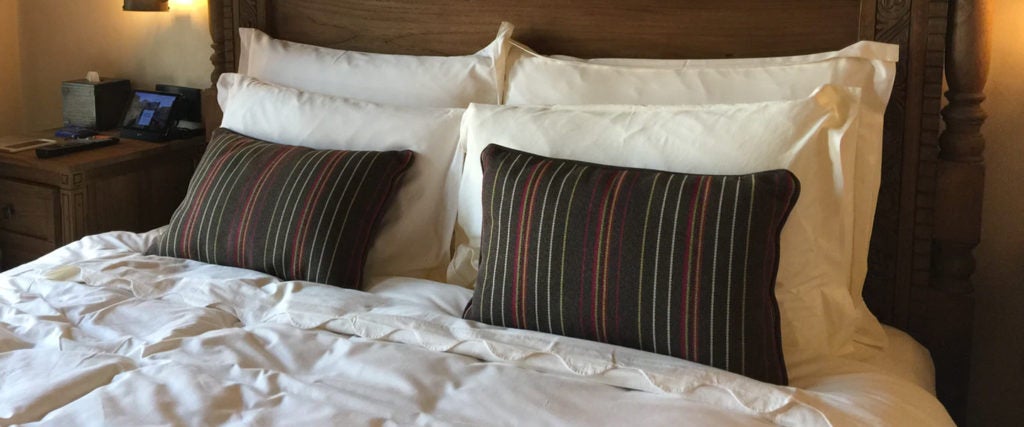Certain things in life are a given: Wearing clothes in public, brushing your teeth in the morning (and hopefully at night), closing the door behind you when you leave your house. But amongst these general acts of societal indoctrination is perhaps the most basic — that of using a pillow. Think about it: Have you ever deliberately slept in a place and thought, “No, I don’t need a pillow.” Of course not. Pillows are a must have. They’re the opposite of the cherry on top. A pillow — in the context of sleep stuff — is the sundae.
Of course most dudes, as we’ve previously reported, opt for the very melted, barely-hanging-on-to-any-sense-of-puff, pillow. This isn’t an accident — most dudes, up to a certain age, just rely on mom to buy them home goods. As such, they’re likely using their college pillow up until the point where their significant other buys them their first non-mom pillow.
But rather than once again bother to question the, let’s call it, “reluctance,” of men to have even the slightest semblance of domestication, why not question the entire pillow-neck-support complex. In other words, why a pillow? Can’t we just sleep flat? Might it even be better for our posture to sleep without one?
Probably not, but only because the pillow is about as ancient of a concept as civilization itself. According to SleepCity.com, pillows have been around since 7,000 B.C. “Of course, they were made of stone and so understandably less comfortable; very unlike what we think of as pillows today,” the site reports. “In fact, it is said that these stone pillows were made to help keep bugs from crawling into the ears of wealthier citizens.”
In fact, the soft pillow renaissance didn’t take place until the ancient Greeks and Romans began using “materials such as cotton, reeds or straw, while the wealthy used soft down feathers,” per WallsWithStories.com. But even then, the “soft pillow” was mainly reserved for the elite. “King Henry VIII banned the use of soft pillows for anyone except pregnant women,” reports WallsWithStories.com. “However, by the 16th century, the pillows were once more widespread, although the stuffing inside had to be regularly changed due to mold and vermin.”
Thankfully, most modern pillows — which are filled with either memory foam, polyester, feathers or down — are unlikely to get moldy (so long as you wash them semi-regularly).
But again, why do we need them in the first place?
As it happens, if you’re the sort of person who sleeps on their stomach, you don’t need one at all. “According to the University of Rochester Medical Center, sleeping on your stomach puts your spine in an unnatural position,” reports Healthline.com. “That’s because the majority of your weight is in the middle of your body. It adds stress on your back and neck, making it hard for your spine to maintain its natural curve.”
Surprisingly, though, there’s plenty of evidence that sleeping sans pillow is much better for your health. “Sleeping without pillows will help your back extend, and you will rest in a natural position without any consequences or aches,” reports SleepAdvisor.org. “Using a pillow that is too soft can strain your neck muscles and even decrease the blood flow to your head. If your head tilts downward on a pillow that doesn’t provide adequate support for your head, then your airflow through the respiratory system will be significantly reduced, which often results with waking up with a headache. In addition, pillows can interfere with continuous positive airway pressure (CPAP) treatment for people with sleep apnea. “CPAP keeps your airway open by means of a bedside device that pushes air through a mask you wear while you sleep,” per the Harvard Business Review.
Still, there are some benefits to the pillow. Foremost among them, they help if you sleep in what physical therapist Trina Bellendir refers to as “neutral posture.” Basically, if you’re laying on your side, a pillow can help you maintain a normal cervical and lumbar lordosis (i.e., your spine’s natural curve).
But also, according to the authors of the same study from the University of Rochester Medical Center, “if you sleep on your back, a small pillow under the back of your knees will reduce stress on your spine and support the natural curve in your lower back.” More importantly, Bellendir suggests that if your hips are wider than your knees, “a pillow will help maintain your straight spine if you’re laying on your side.”
To that end, the same study suggests that “a firm pillow between your knees will prevent your upper leg from pulling your spine out of alignment and reduce stress on your hips and lower back.” “Pull your knees up slightly toward your chest,” write the study’s authors. “The pillow for your head should keep your spine straight. A rolled towel or small pillow under your waist may also help support your spine.”
The other advantage, according to the Harvard Business Review, is that pillows help heartburn symptoms. “Sleeping with your upper body elevated at an angle can also reduce symptoms of sinus problems and may prevent relapses of benign paroxysmal positional vertigo — a condition in which tiny crystals in the inner ear become dislodged and cause extreme dizziness,” it writes.
All of which is to say, even though most of us assume we need pillows in order to sleep properly, that’s not at all the case. In that sense, maybe it’s time to apologize to the dudes with the flat, melted pillows that barely alter the body’s natural lordosis. Based on the science, they’ve been right all along.

